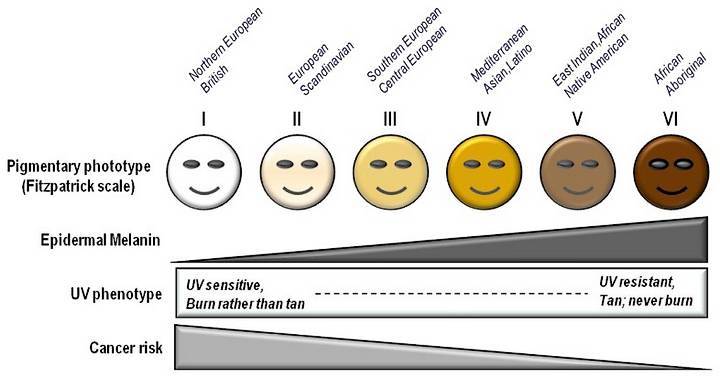Recent research using an ultra fast laser spectrometer has shown how quickly our skin could be damaged by UV rays. A few trillionths of a second can bring potentially dangerous DNA changes, which form pre-cancerous lesions.
This will help with understanding skin damage from the sun and confirms the damage is not entirely colour dependent. There are differences, darker skin offers more protection from the sun but is far from immune.
Further research on the way cancer spreads throughout the body suggests the same. This can happen to anyone, although genetic disposition matters and skin deep variations in colour do not seem to make key traits more, or less likely.
Our core message is that skin cancer is rarer on dark skin but as with sunburn, there is no guarantee. In a survey of 30,000 people, 29% of those with olive skin and 13% of people with black skin had suffered from notable sunburn.
We should all take steps to protect our skin from skin cancer, which at the same time protects from ageing and more immediate problems, such as heat stroke. The risks can however be quantified to a degree.
Skin Categorisation
The Fitzpatrick scale is a way to classify how skin types respond to UV rays. Developed by reality as much as theory, with many people interviewed on how their skin reacts to the sun and by integrating input from dermatologists.

As in the image above, the scale provides six classifications:
- 1. Will always burn and almost never tan. Those with this skin type have very white skin and freckles.
- 2. Burns easily, may tan to an extent, but with difficulty. People with this skin type have white skin.
- 3. Burns mildly and tends to tan gradually. Populations with this skin type have fair, or beige skin.
- 4. Quite rarely burns and in most cases tans easily. A skin grouping generally described as brown skin.
- 5. Rarely burns and tans more easily than type 4. People with this skin type have darker brown skin.
- 6. Almost never burns, will tan readily and substantially. A skin type described as having black skin.
The darker the skin tone, the lower the risk of sunburn. There is however still a risk of some sunburn in nearly all skin types, even though this may be harder to detect.
Without visible signs, your skin may feel hot, sensitive, painful, or itchy. These are signs of over exposure and whilst other causes exist, this exposure can be a significant part of developing skin cancer.
A Realistic View
We have linked sunburn and skin cancers because the relationship is well known. Even so, sun exposure raises skin cancer risk without burning and for those of us who tan easily, the sun can still cause cellular damage leading to cancer.
There is no doubt that having dark, or black skin will help but this should not create a feeling of immunity. Behavioural decisions and sun protection, such as sunscreen, or suitable clothing are still important.
Having your skin checked professionally at intervals makes sense and most importantly, symptoms should not be ignored. The feeling of not being able to get skin cancer can be a barrier to vital early treatment.
By all means see more on skin cancer and wider dermatology for darker skin, or contact our staff at any time if we can offer advice.
For any assistance, or to book a consultation, call 020 8441 1043, or send an email via the Make An Appointment button below.
